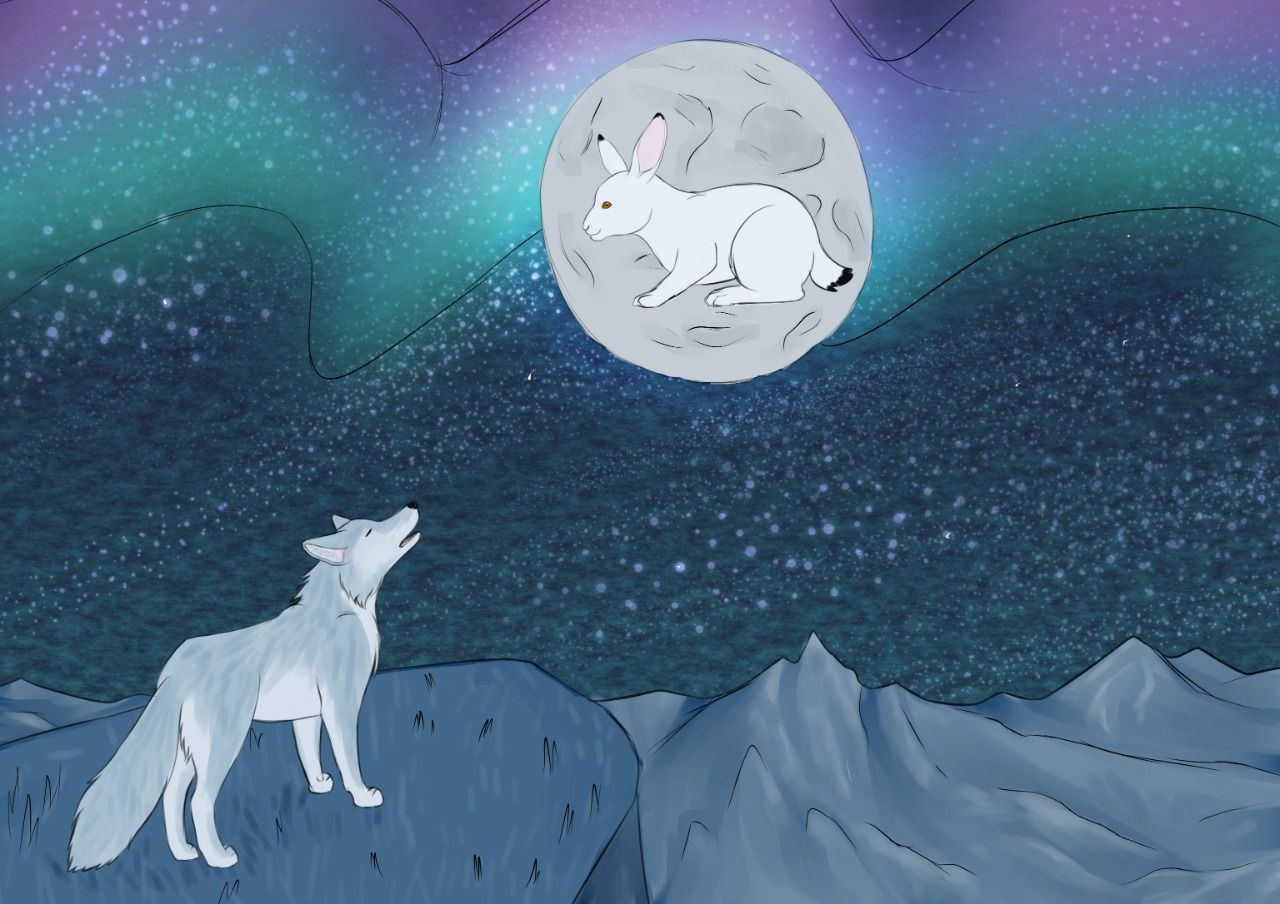Moon-struck
The moon has had an impact on art and science alike. What makes this luminous blob so enticing?

The moon has had an impact on art and science alike. What makes this luminous blob so enticing?
What is a more apt name than Khonsu, which means traveller, for the Egyptian god of the moon who watches over those who travel at night and prevents all evil from occurring? The myths explain that for the travellers in the dark who need light, Khonsu (the moon) shines for them. Not only does it provide light, but it also induces cattle to become fertile, women to conceive and every living creature to suddenly breathe in fresh air!
In the contemporary portrayal of Khonsu, in the Marvel show Moon Knight, one can clearly see him adorning a crescent above his head, depicting the moon. (Of course, it was always a part of the art depicting the moon god, the creators of Marvel didn’t quite design that!) But he’s not the only moon deity to wear such an emblem, Selene, the Greek goddess of the moon too wears it.
Both Khonsu and Selene are also associated with love. Lovesick women would pray to the goddess for help; they believed that she could understand them because she too was forever yearning for her love, the Moon to the Sun. Similar to the Egyptian god, Selene too is linked to childbirth, as it was believed in ancient Greece that women had the easiest labours during a full moon.
Why are so many moon-related mythologies connected to fertility and menstrual cycles? Is there any truth to it, or should it be dismissed?
Of all the things, real or fake, from our stories and ideas of the moon, there is one thing that we know is irrefutably true: the phenomenon of lunar phases. We see the moon in phases because the area of the moon that is directly lit by sunlight changes each night. These phases cycle over a synodic month, or 29.53 days.
The phases of the moon can be described qualitatively, too — we have eight names for them. These are: new moon, waxing crescent, first quarter, waxing gibbous, full moon, waning gibbous, last quarter, and waning crescent. (Then, of course, you get to the new moon again).
When you think about how many humans have stared in wonder at the moon, the amount of art it has inspired is not a surprise. There’s poetry, paintings, and science fiction in droves. But perhaps the most famous artwork with the moon is Van Gogh’s starry night.
It depicts the night sky, just before sunrise. They aren’t in the painting, but Van Gogh himself would have seen this view through iron bars — he was in an asylum in Saint-Rémy-de-Provence, following an acute mental breakdown and depressive episode.
Some of the astronomical details of these paintings are stylised (for example, the moon was actually in a waning gibbous at the time Van Gogh painted it, on around 18th June 1889), but others are correct. Research has shown that Venus was visible in Provence in the spring of 1889, and was actually at its brightest. This means that the brightest star in the painting, (just to the viewer’s right of the cypress tree, about halfway down) is actually Venus. Further proof for this comes from a letter Van Gogh wrote to his brother Theo, stating that he “saw the countryside from my window a long time before sunrise with nothing but the morning star, which looked very big.” (The morning star is another name for Venus).
The grey-pelted wolf streaks past, pausing only when she reaches the edge of the cliff. Lifting her snout, she lets loose a deep and lengthy howl that carries over the valley below and up to the mountains ahead. Her fine grey hairs are illuminated by the full moon above, as if she was the heroine in a broadway show.
The moon has myths. Now, most of them sound absurd or weird or magical, and our science-believing brains reject them easily. Of course, wolves don’t howl at the moon! It might seem like that, but it’s actually because they are nocturnal creatures, and so would howl in the night and not during the day. Their snouts face upwards to carry the sound further, and they howl to alert newcomers, hunt prey, and even to describe their health to a friend!
Seems like an easy enough explanation. But what if some moon myths were true?
Through the ages, we’ve seen that fertility and menstrual cycles keep interconnecting with the moon. While the myths around fertility are just that — myths, there is some connection with menstrual cycles: the average length of a woman’s menstrual cycle matches the moon’s waxing and waning cycle, a rather convincing sync.
There is also research now, to show that our moods and sleep cycles are also connected to the moon cycle. Who knows, maybe in a few years, even our disbelief at fertility increasing at the full moon, might have to be dissolved!
The moon has been part of our music for a long time, though not always in the way you expect it to. Even though epics of songs have love and moon-sickness written in their lyrics, British band Pink Floyd’s The Dark Side of the Moon hardly mentions it. And yet, their metaphor uses the side of the Earth’s moon that is perpetually out of sight to us to express all the sides of humans; the parts we can’t always see, but still exist.
The Dark Side of the Moon expresses “political, philosophical, humanitarian empathy that was desperate to get out” as Roger Waters, band member and lyricist of the album, exclaims. The album is a lyrical and musical wonder, but they too adopted this phrase about the moon to perfectly describe what their content is about.
A common misconception is that the dark side of the moon receives less sunlight than the other side of the moon, but this is not true, demonstrating further that the dark side is the side we can’t see, not the literal dark side!
Perhaps a better term, then, would be ‘far side of the moon’ — but can you see that phrase having such a cultural impact?
All of us have squinted at the moon trying to find images in the contrast of light and dark upon the moon’s surface. The technical term for these pictures is Lunar pareidolia, and different cultures have found a feminine figure, a face, a toad, a moose, and even a buffalo! One of these, the rabbit or hare, can be found in folklore from both Asia and the Americas.
One Buddhist Jataka tale describes how a monkey, otter, jackal and rabbit (or a fox, monkey and rabbit, in the Japanese version of the tale) vow to practise charity on the day of the full moon. On seeing an old man, all the other animals are able to help him, but the rabbit only knows how to gather grass. And so, it offers itself. The man is touched by this devotion, and revealing himself to be a magical deity, he puts the rabbit’s image on the moon, memorialising it for the rest of time.
An Aztec myth is strikingly similar: when the god Quetzalcoatl roamed the earth and was hungry, a rabbit offered herself up to him. Touched, he lifted her up to the moon, lowered her back down, and declared that she would be remembered forevermore.
There are other links between a rabbit and the moon; in Mayan hieroglyphics, a rabbit is often paired with the moon goddess. Mesoamerican legends also link the two.
Just as the geography of the earth has been studied, so has the geography of the moon. The interplay of light and darkness on the moon’s surface that has been the genesis of so many myths is actually caused by an interplay of minerals: the darker areas have a lot more basalt
These darker areas are also called seas, or lunar maria (that’s a plural word, the singular is lunar mare). The name comes from early astronomers who mistook the plains for actual seas. In reality, they are dark because of their iron-rich composition.
Lunar mare (with the exception of two) follows a specific nomenclature. They are either named after features (sea of moisture, sea of clouds) attributes (southern sea, eastern sea, sea of the edge) or states of mind (sea of tranquillity, sea of serenity, sea of crises). Following this tradition, Mare Moscoviense was only accepted as a name by the International Astronomical Union with the justification that Moscow is a state of mind.
From Egypt to India, we have travelled all over the globe with stories of the moon. One could even say that it was like the journey of the moon through the night!
This natural phenomenon has embedded itself in almost every culture, it has even found its standing in science, an area that expands every day, whether it be what makes up the dark side of the moon, or the brightest star in Van Gogh’s Starry Night.
Maybe next time you gaze at the moon, you will see the rabbit in the moon, or think about howling wolves and protective gods. Or maybe, you’ll just admire its beauty and go back to sleep.
